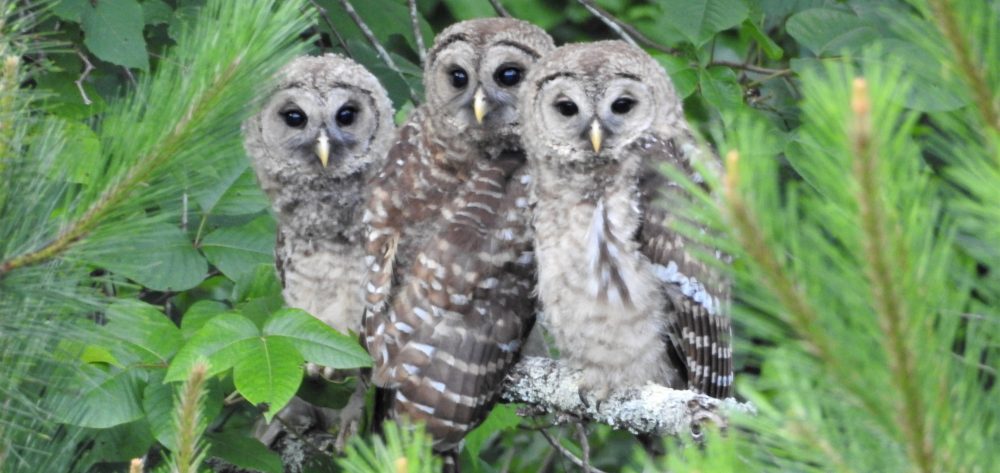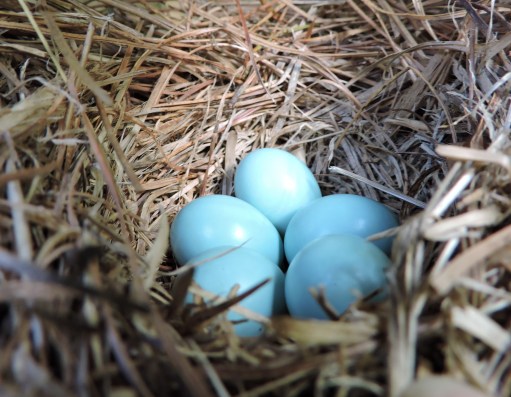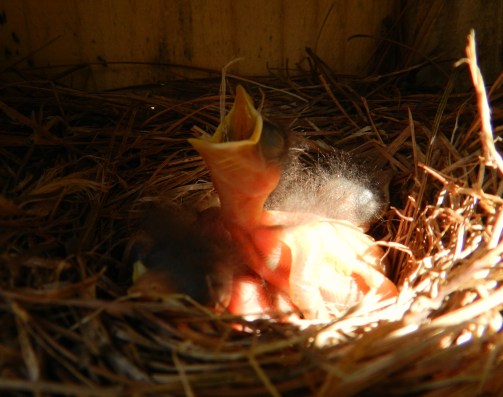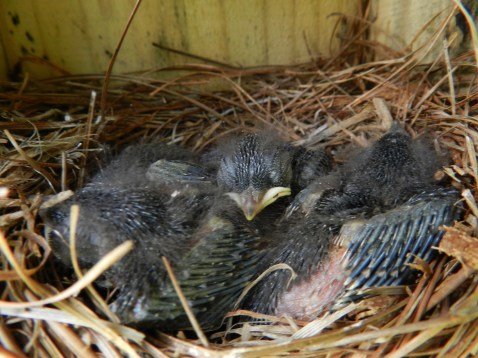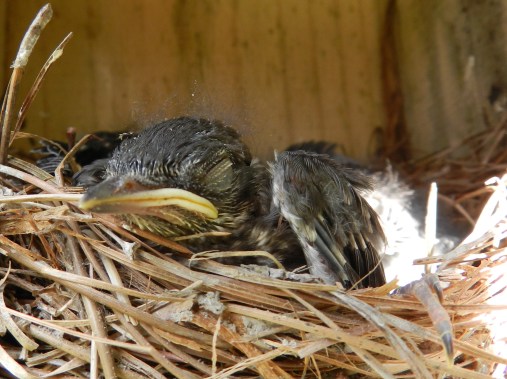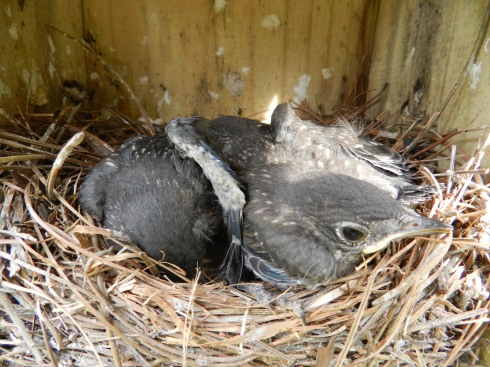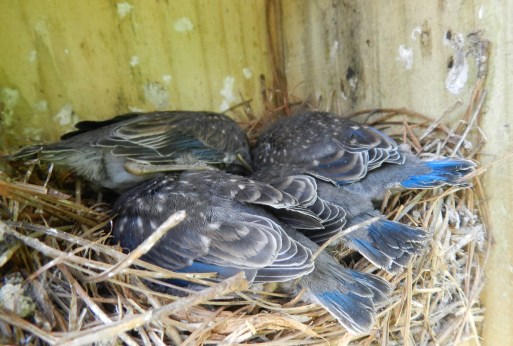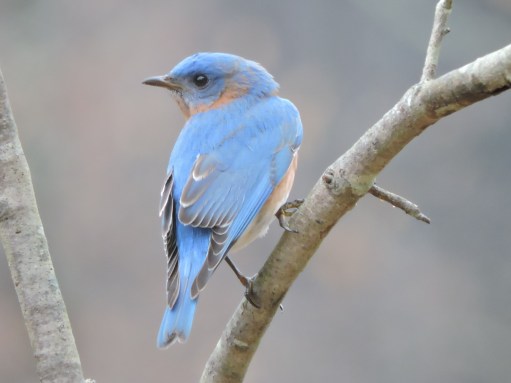For the last handful of years, my family has had the good fortune to have a pair of Eastern Bluebirds grace the nest box in our tiny suburban backyard. When we set up a box this spring in our new backyard (a suburban oasis I wrote about here), I feared we might not see any action this year because several dead trees on our property provide natural cavities. Typically, we see males start to check out the box for a period of days beginning in February, perching on top, fluttering their wings, and flying in and out carrying nesting material. Once a female is sufficiently impressed, she takes over all of the nest construction and egg incubation, and the male delivers food to her while she is on the nest. I only saw a bird fly into the house once or twice after we set it up, and never with nesting material, so when I peeked in the box in mid-April, I was surprised to discover not only a nest, but five gorgeous blue eggs.
Every few days, I checked on the nest to monitor the progress of the clutch. Aside from my personal interest in the nest’s success, I had registered to monitor the nest with the Smithsonian Migratory Bird Center’s Neighborhood Nestwatch program, a citizen science program that provides scientists with hard-to-get data about the survival rate of backyard birds. Nestwatch scientists also visited my home recently to band some of my backyard birds so that I can monitor them and record sightings into their database. Participating in such programs is a great way to spark curiosity and excitement for birds in kids and adults alike, as well as a way to contribute valuable data that scientists can use to guide conservation measures. If you have an accessible, active nest in your yard, I encourage you to register with Nestwatch and record your observations, but do make sure to read the important nest monitoring guidelines first so that you don’t hinder the success of the nesting efforts.
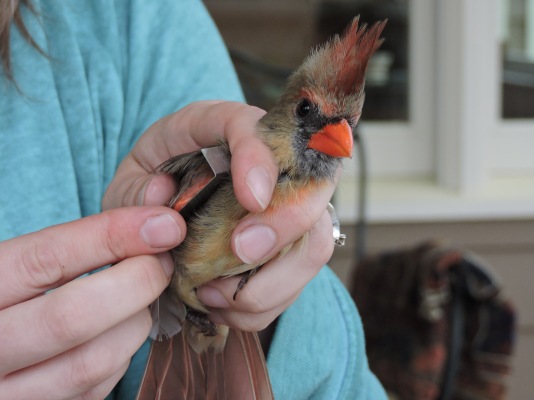
Scientists from the Smithsonian’s Nestwatch program visited our home in April to catch and band birds for us to monitor. The program provides valuable data for scientists about backyard bird populations.
Bluebird babies take about two weeks to hatch and just another two weeks to fledge. As with all babies, they grow up way too fast—in just a blink of their sleep-deprived parents’ eyes. Every three days or so, I’d watch for the parents to fly off, then take a quick peek in the nest and snap a photo.
Watching the adults bring food back to the nest was fascinating. Each afternoon after work, I sat on our front steps to enjoy the show from a distance. Mama bluebird brought back much larger prey items than Dad did, and she was also more reluctant to enter the nest box while I was watching than he was. I watched her bring various large flying insects or earthworms back to the nest on several occasions, but I rarely saw her go in. I’d take my eyes off the box for just a moment only to turn back and see her flying off out of sight. One afternoon she even brought a lizard back to the nest!
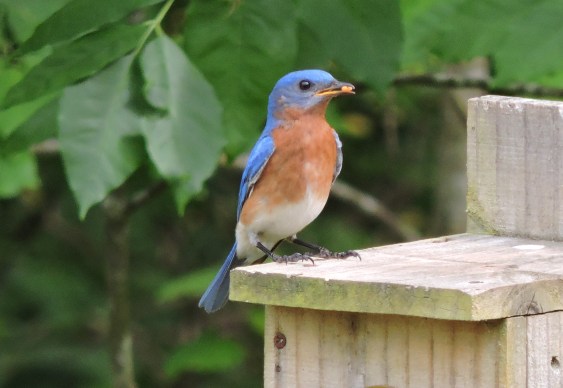
Daddy Bluebird was an attentive father. He brought smaller food items to the nest, but seemed to make more frequent visits.
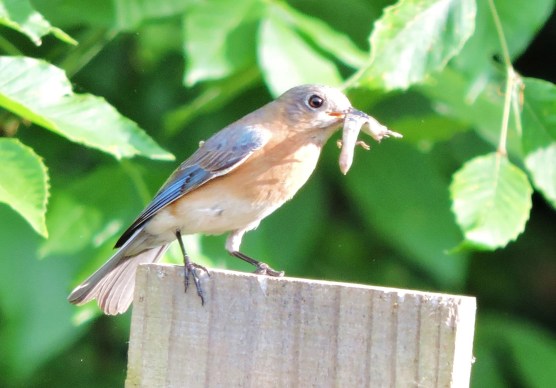
The female pounded and pounded this hapless lizard on the top of the nest box! I didn’t notice until I cropped my photo that the lizard appears to have already dropped its tail—so much for that defense mechanism. I’m not sure, but I think she gave up and flew off with it rather than feed it to her young. It would have been quite a mouthful!
As the chicks neared two weeks of age, I frequently saw them poke their heads up to look out of the box. I knew their time to fledge was approaching and hoped it wouldn’t occur the day I would be out of town for a work event. In spite of careful observation in past years, I’ve never seen the babies leave the nest, and I was hoping this year I might get lucky. When I checked the box first thing in the morning after my work trip, I was crushed to discover that the nest was empty. Not only had I missed their departure, they had chosen the first cool, stormy day in almost three weeks to do so. I looked high and low in all the surrounding areas. In my experience, baby birds typically hang around low to the ground for a day or two, or at least up in the trees in the area near the nest, but these baby bluebirds were nowhere to be found. I listened for their begging calls and could detect nothing, and I saw no sign of the parents. I worried that a snake had taken the whole clutch before they even left the nest (which is exactly the reason why birds leave the nest as soon as they are able, often when they haven’t mastered flying yet). I worried that a predator had gotten them after they left the nest. I worried that they had gotten wet or gotten lost and succumbed to chill. Feeling disheartened, I headed to work.
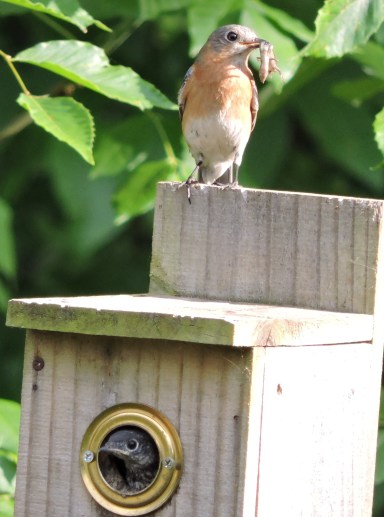
The babies are almost ready to explore the world. Their heads popped up each time their parents visited. 5/15/15
When I returned home that afternoon, I immediately set myself on the front steps with my binoculars. After several minutes I saw the male fly in and grab an insect from the ground and fly off into some distant trees. Several minutes later I saw the female do the same, but I couldn’t make out where they had gone. Surely the babies weren’t that far away? Were the adults just returning to business as normal? The sinking feeling returned. Determined to know more, I watched several more minutes until the male returned to the yard again. This time as he flew off, I changed my vantage point and watched as carefully as I could with my naked eye as he landed at the top of a tremendously tall tree. I could just make out the fluttering of wings and distant begging calls. The babies were safe—and apparently very well equipped to get off the ground! Phew! As much as I had hoped they would hang around a little longer, I was relieved and happy to see them safe and sound—the best cure for empty nest syndrome. If I’m lucky, the parents may return to raise one more clutch before the summer is over!
Note about bluebird conservation:
I’ve commented in the past that I must have walked through the first four decades of my life with blinders on not to have noticed the beauty and diversity of bird life around me, but I think that even had I been paying more attention growing up, I wouldn’t have been likely to see an Eastern Bluebird in my backyard. Eastern Bluebird populations steeply declined in the early part of the 20th century as habitat loss and competition from introduced species such as European Starlings and House Sparrows made nesting holes increasingly difficult for bluebirds to claim. Fortunately today, in spite of the tremendous pressures facing birds, the Eastern Bluebird seems to be doing just fine. The establishment of bluebird trails and other nest box campaigns beginning in the late 1960s helped Eastern Bluebird populations rebound by almost two percent per year between 1966 and 2010.* The success of these efforts is an important reminder that when we work collectively to make small conservation actions, we can effect significant change. So, leave those dead trees standing (60 species in N. America are cavity nesters!), or put up a nest box or two (make sure it is designed to keep out the larger non-native and more aggressive starlings). I’m doing my part! *www.allaboutbirds.org/guide/Eastern_Bluebird/lifehistory
